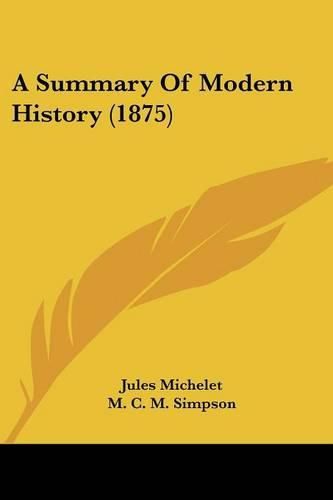Readings Newsletter
Become a Readings Member to make your shopping experience even easier.
Sign in or sign up for free!
You’re not far away from qualifying for FREE standard shipping within Australia
You’ve qualified for FREE standard shipping within Australia
The cart is loading…






Purchase of this book includes free trial access to www.million-books.com where you can read more than a million books for free. This is an OCR edition with typos. Excerpt from book: SUMMARY MODERN HISTORY. INTRODUCTION. In the Ancient History of Europe the scene is occupied alternately by two predominant nations or peoples; and for the most part there is a unity both of action and interest. This unity, which is less visible in the Middle Ages, reappears in Modern History, and manifests itself chiefly in the revolutions of the Balance of Power. The date which separates the History of the Middle Ages from Modern History cannot be assigned with precision. If we consider the History of the Middle Ages as ending with the last Invasion of the Barbarians (that of the Turks), Modern History will include the three centuries and a half which separate the taking of Constantinople by the Turks from the French Revolu- tion, 1453?1789. Modern History we may divide into three great periods: ? I. From the taking of Constantinople to Luther’s Reformation, 1453?1517. II. From the Reformation to the Treaty of Westphalia, 1517?1648. III. From the Treaty of Westphalia to the French Revolution, 1648?1789. ‘ 0 s. H. B 2 MODERN HISTORY. The system of the Balance of Power which was coming into existence during the first period, took its perfect shape in the second, and was maintained in the third. When viewed relatively to the Balance of Power, the two latter periods fall into five separate sub-divisions of that system: 1517?1559; 1559?1603; 1603?1648; 1648 5?1789- PRINCIPAL CHARACTERISTICS OF MODERN HISTORY. I. The great States which are formed by the successive falling in of fiefs have a continuous tendency to swallow up smaller States, either by way of conquest or by marriage. (1.) Republics are absorbed by Monarchies; Elective States by Hereditary States. This tendency to absolute unity is checked by the Balance of Power. (2….
$9.00 standard shipping within Australia
FREE standard shipping within Australia for orders over $100.00
Express & International shipping calculated at checkout
Purchase of this book includes free trial access to www.million-books.com where you can read more than a million books for free. This is an OCR edition with typos. Excerpt from book: SUMMARY MODERN HISTORY. INTRODUCTION. In the Ancient History of Europe the scene is occupied alternately by two predominant nations or peoples; and for the most part there is a unity both of action and interest. This unity, which is less visible in the Middle Ages, reappears in Modern History, and manifests itself chiefly in the revolutions of the Balance of Power. The date which separates the History of the Middle Ages from Modern History cannot be assigned with precision. If we consider the History of the Middle Ages as ending with the last Invasion of the Barbarians (that of the Turks), Modern History will include the three centuries and a half which separate the taking of Constantinople by the Turks from the French Revolu- tion, 1453?1789. Modern History we may divide into three great periods: ? I. From the taking of Constantinople to Luther’s Reformation, 1453?1517. II. From the Reformation to the Treaty of Westphalia, 1517?1648. III. From the Treaty of Westphalia to the French Revolution, 1648?1789. ‘ 0 s. H. B 2 MODERN HISTORY. The system of the Balance of Power which was coming into existence during the first period, took its perfect shape in the second, and was maintained in the third. When viewed relatively to the Balance of Power, the two latter periods fall into five separate sub-divisions of that system: 1517?1559; 1559?1603; 1603?1648; 1648 5?1789- PRINCIPAL CHARACTERISTICS OF MODERN HISTORY. I. The great States which are formed by the successive falling in of fiefs have a continuous tendency to swallow up smaller States, either by way of conquest or by marriage. (1.) Republics are absorbed by Monarchies; Elective States by Hereditary States. This tendency to absolute unity is checked by the Balance of Power. (2….